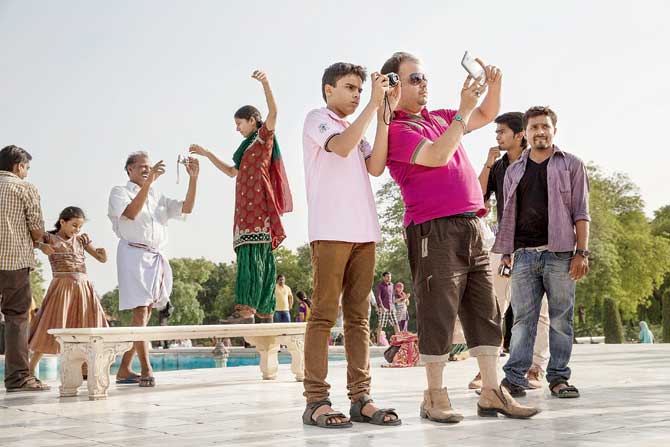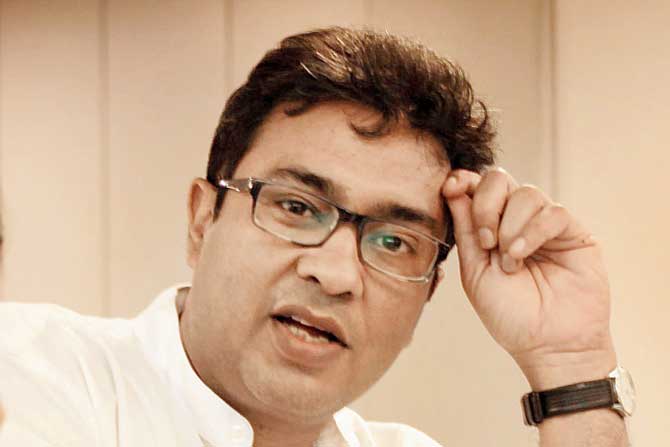Blue, green or white? Insect secreta or too many humans? Ahead of a scientific investigation to judge what the "real" colour of the Taj is, historians and environmentalists say ASI is missing the woods for the trees

The discolouration of the Taj Mahal has been an issue since the 1980s, when MC�Mehta, a Supreme Court attorney, in 1984, filed a writ petition mentioning the adverse effects of the industries and vehicles within the vicinity of the monument. Pics/Get
That the Taj Mahal is white has been endorsed by history text books for decades. Reams of literature have paid ode to its regal white splendour. However, the decades starting from the 1980s have been seeing the white getting tainted bit by bit. With the setting up of the Mathura Refinery 50 kilometres away, the Taj Mahal began to develop a yellowish tinge.
ADVERTISEMENT
Rapid industrialisation in the adjoining areas made things worse, and the colour turned from yellow to brown and green. Earlier this month, following concerns of the changing colours of the Taj expressed by the Supreme Court, Union culture minister Mahesh Sharma declared that a committee shall be formed to conduct a scientific study to assess the original colour of the Taj. However, the question remains that should the focus be on whether or not the Taj was white as opposed to thwarting its discolouration once and for all.
The insect deposit
In 1979, when the Mathura Refinery was going to be set up, Mahesh Chandra Mehta, then a Supreme Court attorney and an active environmentalist, raised his voice against the impending environmental menace. Helping him in his cause was late scientist, Dr Shivaji Rao. In 1984, Mehta filed a writ petition mentioning the adverse effects of the industries and vehicles within the vicinity of the monument.
He claimed that due to the direction of the wind, 900 kilos of sulphur dioxide was blowing towards the Taj every hour, thereby corroding the marble, leading to a phenomenon called the"marble cancer". The case, commonly called the Taj Trapezium case, had Mehta asking government authorities to lay down immediate steps to stop air pollution in the area."It was my first environmental case. A parliamentary committee was set up that said that even one per cent risk to a monument like this is hazardous.

It was a blunder committed by the government to set up a refinery so close to the Taj Mahal." Mehta was resilient in his fight and in 1996, the court ordered that industrial growth be stopped in the area."They enforced a mechanism to follow the directives. The regional commissioner of Agra was initially giving the court bi-monthly reports. Some industries were relocated. But later on, when the case was not being heard regularly, it started slipping."
Mehta points out how due to the pollution in the Yamuna, the Taj is also being attacked by insects."Earlier, the fish in the Yamuna would eat the insects. These insects come in hoards and sit on the marble. Most of them, when they die and decompose, leave behind a green secreta, which has added to the Taj Mahal-s colour," says the 71-year-old Magsaysay and Padma Shri awardee.
How white is white?
The Taj Mahal was built in the 17th century by Mughal Emperor Shah Jahan on the south bank of the Yamuna. Legend has it that countless precious and semi precious gemstones that its interiors were once adorned with were plundered in the later years. The white marble structure is built on a foundation of wells, says Delhi-based historian Shashank Shekhar Sinha."The Makrana marble used in the Taj has a crystalline quality, which allows light to enter deep.
This phenomenon acts differently according to time of day and also the season. The Taj is pinkish in the morning, dazzling white at noon, a golden orange in the evenings and another kind of white at night. What is your reference point then? One must remember that the whole idea of white is relative here," he says.
Sinha, who has been writing on heritage sites for over a decade now, says that the Mathura Refinery is not the only menace. From November, 2011 to November, 2012, a team of scholars from India and the US studied the effects of black and brown carbon [emitted from vehicles and burning of solid waste] on the Taj . The alarming amounts of tourist traffic has also added to the discolouring.

"According to data collected from 2014 to 2016, eight million tourists visit the Taj in a year. On some days, the traffic goes above 50,000 a day. The humidity caused by human presence in inner chambers has led to the discolouring of its interiors. Imagine how many hands are touching the Taj. I-ve seen most guides touch the facade while talking to tourists. And with digital photography and selfies, people are spending more time there, thereby increasing the amount of human touch," adds Sinha.
Imran Khan, 30, has been a tour-guide at the Taj Mahal since 2010. He agrees that visitors touch the surface of the monument."Especially first-timers who are more enthusiastic. You-ll notice patches up to a height of eight feet, which is the maximum someone can stretch if they raise their hands. But, guides don-t touch. We care for the Taj more than visitors," he says. Locals are more concerned about the Yamuna problem."It-s smelly and a breeding ground for mosquitoes that get drawn to the white colour of the Taj, and then leave a green mark on it. If the Yamuna is cleaned, more than half the problem can be solved," adds Khan.
The need of the hour
"If your house is on fire, will you philosophise on the fire, or will you try to douse it first?" says Mehta, adding,"Of course the Taj is white, but I-m no archaeologist. My point is, when the monument is in grave danger, is it more important to save it from further damage or find out if it was white or not. The effects of climate change on the Taj are tremendous. I have fought for this for more than half my life.
The government needs to issue a white paper directive to ban industrial expansion around the Taj." Sinha suggests that the intervention needs to be deeper."The authorities need a long term, holistic approach to look at the problem. We need a comprehensive heritage policy, share expertise from other countries. Construction of public infrastructure within 100 metres of the monument needs to stop now. Whatever colour they find the Taj to be is bound to be disputed. But, is that even the real problem?"
Catch up on all the latest Crime, National, International and Hatke news here. Also download the new mid-day Android and iOS apps to get latest updates
 Subscribe today by clicking the link and stay updated with the latest news!" Click here!
Subscribe today by clicking the link and stay updated with the latest news!" Click here!






